Exploring Flight Patterns of Pet Birds
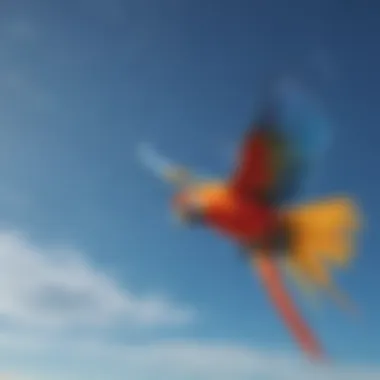
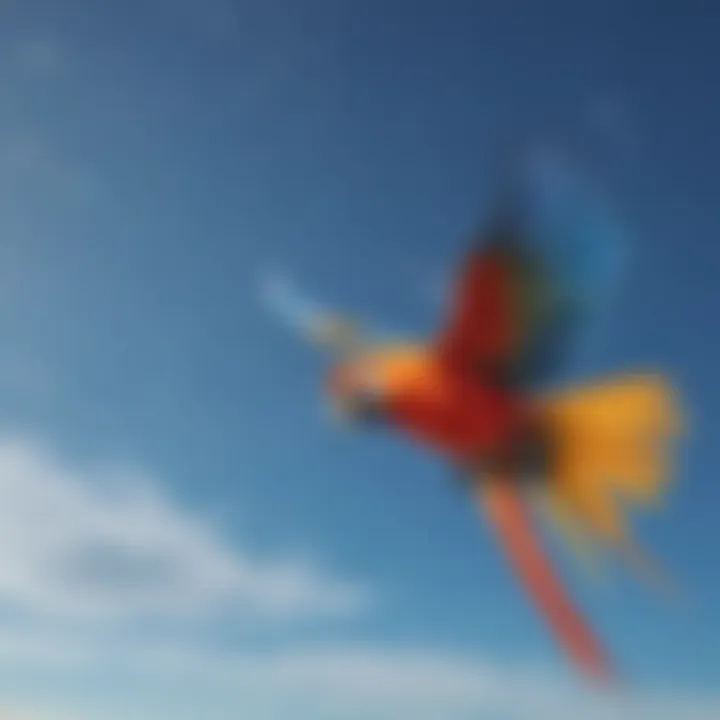
Intro
Understanding the flight patterns of pet birds is more than just a fascination; it is an integral part of ensuring their health and happiness. Flight is instinctual for these creatures. Providing a conducive environment allows birds to express their natural behaviors, which is key to their well-being. Yet, this comes with challenges that all bird owners must navigate. We’ll explore the different aspects of this topic, from daily care routines that support flight to recognizing the importance of enriching their life
Care Tips
A well-cared-for bird is a happy bird. Let's dive into some practical care tips that can help you establish a nurturing environment for your feathered companion.
Daily Care Routines
Daily care routines are the bedrock of a pet bird’s health. This starts with a consistent schedule for feeding, as birds thrive on routine. Offer fresh food each morning and ensure they have access to clean water at all times. Observing your bird’s habits will help you understand when they are most active, which is critical for effective interaction and playtime.
Cage Setup and Maintenance
The cage is your bird’s home base, and a well-set-up cage can make all the difference. Choose a spacious cage that promotes flying and movement; a larger space enables birds to stretch their wings fully. Make sure to arrange the perches at varying heights and include some toys for mental stimulation. Also, pay attention to the material of the cage. Stainless steel cages are a good investment as they resist chewing and are easy to clean.
Hygiene and Cleaning Practices
Cleanliness is paramount in maintaining a healthy environment. Regularly clean food and water dishes, typically at least once a day, to prevent bacteria buildup. The cage should be thoroughly cleaned once a week. Remove droppings and replace bedding and liners. Not only does this keep your bird healthy, but it also fosters a more pleasant living space.
Seasonal Care Adjustments
Seasons can greatly affect your pet bird’s routines and needs. During colder months, ensure they are kept warm and sheltered from drafts. In contrast, summer months may require additional hydration and shade. It's wise to be observant and adjust care practices accordingly.
"A happy bird is a healthy bird!"
- Ensure your pet has room to fly and explore safely.
Behavioral Insights
Understanding your bird’s behavior is just as crucial as their physical care. Birds communicate through body language, vocalizations, and through play.
Understanding Bird Body Language
Birds use body language to express their emotions. A puffed-up bird can indicate relaxation or contentment, while a bird with ruffled feathers might be feeling threatened. Pay attention to interactions with you and with their environment; small shifts can reveal much about their mood.
Common Behavioral Issues and Solutions
Behavioral problems often stem from a lack of stimulation or boredom. If your bird is overly aggressive, anxious, or engaging in excessive feather plucking, it’s time to consider their environment. Increasing interaction time or introducing new toys can help redirect their behavior positively.
Positive Reinforcement Techniques
Training can be a rewarding process for both bird and owner. Using treats as positive reinforcement establishes a bond and encourages desired behaviors. Simple tricks like stepping up onto your finger or learning to come when called help build that trust and understanding.
Social Interaction Needs
Birds are social creatures, often thriving on companionship. Whether it’s other birds or human interaction, they need social engagement to stay emotionally balanced. Schedule playtime outside the cage to maintain their social habits and improve their quality of life.
Nutrition Guides
The right diet plays a critical role in a bird's flight ability and overall health. A balanced intake provides the necessary nutrients that support strong muscles and feathers.
Essential Diet Components
Birds need a mix of seeds, pellets, fruits, and vegetables in their diet. High-quality commercial seed mixes can be supplemented with fresh produce like leafy greens and berries.
Safe and Toxic Foods
Understand what foods are safe and which are harmful. For instance, avocados and chocolate are toxic to birds. Consulting resources like the National Audubon Society can provide guidance on safe feeding practices.
Supplements and Treats
Sometimes, specialized supplements can be beneficial in maintaining a bird's health. Vitamin formulations and calcium sources can assist in boosting overall wellness. Just be careful not to overdo it; moderation is key.
Feeding Strategies for Different Species
Not all species are alike. Researching the specific dietary needs of your bird will help tailor their meal plans and promote optimal health.
Wellness and Health
Keeping track of your bird's health is vital. Observations made during playtime or feeding can reveal a lot.
Routine Health Checkups
Regular checkups with an avian vet are essential. They can help screen for diseases that may not show clear symptoms at first.
Identifying Symptoms of Illness
Sudden changes in behavior or eating habits are often the first signs of a potential health issue. Watch out for lethargy, changes in feather condition, or unusual vocalizations.
Preventative Care and Vaccinations
Maintaining vaccinations and preventive health measures can protect your bird from common avian diseases. Consult your vet to stay on top of what’s needed.
Mental and Emotional Well-being
Birds thrive on mental stimulation. Incorporate activities and challenges into their daily routine to keep their minds sharp and engaged.
Enriching Activities


Finally, engaging your bird in stimulating activities adds joy to their lives.
Toys and Playtime Ideas
From shredding toys to mirrors, the right toys can keep a bird entertained for hours. Rotate them frequently to maintain interest and excitement.
Training and Tricks
Utilize downtime for training sessions. Simple tricks can engage both you and your bird while strengthening your bond.
Outdoor Activities and Interaction
If safe to do so, outdoor time can provide a host of new experiences. Harness training is an option for birds that allows them to explore safely.
DIY Projects for Mental Stimulation
Creating homemade toys or obstacle courses can be a fun way to stimulate your bird’s mind, engage them physically, and save money at the same time.
By blending these various aspects of care, insight, nutrition, and wellness, bird owners can ensure they are fostering an environment where their feathered friends can truly thrive.
The Importance of Flight in a Pet Bird's Life
When we talk about pet birds, flight isn’t just an activity; it’s a crucial part of their existence, much like breathing. For pet birds, flying is an extension of their natural instincts and a reflection of their inner vitality. Without the ability to fly, a bird may experience a range of issues that affect their well-being.
Understanding Natural Instincts
Birds are, by their very nature, creatures built for flight. This instinct isn't merely about getting from point A to point B, but it encompasses a wide array of survival behaviors seen in the wild. In many ways, allowing our pet birds to engage in flight is akin to granting them a slice of their natural habitat. They instinctively want to fly to explore, evade predators, and socialize.
Birds have an inherent drive to perch at various heights, interact with their flock (or owner, in the case of pets), and even show dominance or submission through flight patterns. When they can't fly, pet birds may exhibit stress behaviors, such as excessive vocalizations or feather plucking. Their wings are not just for a quick jaunt across the living room; it's a lifeline that connects them to their heritage and instincts.
Physical Benefits of Flight
Engaging in flight has plenty of benefits for a bird's physical health. Flight naturally exercises muscles that may go underused during a sedentary lifestyle. A good flap of the wings can enhance cardiovascular fitness and improve overall stamina. This isn’t just fluff; active birds typically boast a healthier weight and toned muscles.
For instance, take a budgerigar that spends a few minutes daily zipping around the living room. It's not just play; it’s a workout. This physical activity contributes to better circulation and healthier bones. Moreover, flight helps in maintaining feather condition and keeps joints flexible. Well-exercised birds often show a reduced risk of obesity-related issues and other health problems.
Psychological Well-Being
Let’s not forget the mental aspect of flying. Just like humans engage in activities that free the mind, pet birds derive similar benefits from flight. It stimulates their senses—sight, sounds, and feeling the air rush past them create a rich tapestry of experiences. Birds are known to be intelligent creatures, and providing them with opportunities to hunt, fly, and explore can significantly enhance their mental state.
Allowing your pet bird to fly can relieve boredom and alleviate stress, leading to a happier and healthier feathered friend. The act of flight encourages curiosity and exploration, minimizing anxiety by engaging their natural instincts.
"A bird’s heart is where its freedom lies. Letting them fly is opening a window to that freedom, irrespective of the confines of a home."
In essence, the importance of flight in a pet bird's life is multi-faceted, resonating through their physical health, psychological state, and natural instincts. For owners, understanding these factors creates a foundation for better avian care, ensuring that the little companions who bring so much joy are living their best lives.
Types of Pet Birds and Their Flight Abilities
Understanding the flight abilities of various pet birds is essential for bird owners who want to facilitate a positive environment for their feathered friends. Each species has unique characteristics that dictate how they fly, their agility in the air, and their specific needs when it comes to flight space and training. Knowing these elements helps owners nurture their birds’ natural inclinations while ensuring their safety and well-being.
Small Birds: Budgerigars and Canaries
Small birds like budgerigars and canaries are often the preferred choice for pet owners due to their lively nature and smaller flight range. Budgerigars, commonly known as budgies, are nimble flyers. These birds can dart around quickly, making swift turns and exhibiting rapid wing beats.
Canaries, on the other hand, have a different flight style – they engage in short, fluttery flights rather than sustained, long-distance glides.
Flight Characteristics of Small Birds:
- Density and Structure: Small birds usually have lighter bodies enabling them to stay airborne with less effort.
- Space Requirements: They generally require a safe area where they can take off and land without obstacles, such as clutter or dangerous objects.
"Small birds can make big impressions with their beauty and charm, but they also need the freedom to explore the skies within safe confines."
Medium Birds: Cockatiels and Conures
Medium-sized birds like cockatiels and conures bring a slightly different dynamic to flight. Cockatiels are agile with their flights; they can perform effortlessly in small environments, yet they thrive in larger spaces where they can stretch their wings. Their flight can entail flapping and gliding, allowing them to perform graceful maneuvers.
Conures offer a burst of energy during flight. These birds have robust bodies and often engage in higher altitude flights. Their playful nature benefits from ample room to soar and explore, which aids in their physical and mental development.
Flight Characteristics of Medium Birds:
- Versatility: Medium birds demonstrate a mix of short bursts and longer glides, making them adaptable to various flight environments.
- Social Interaction: They often use their flight to engage with their owners and other birds, making training crucial to avoid erratic behaviors.
Large Birds: Parrots and Macaws
Large birds, such as parrots and macaws, are the major athletes of the avian world. These majestic creatures are powerful flyers, capable of covering substantial distances. They have strong, expansive wings that allow for sustained flights and intricate aerial maneuvers.
Parrots and macaws often communicate while in flight, using their agility to express emotions or establish bonds. They can soar gracefully, which is not only an impressive sight but is also part of their natural behavior.
Flight Characteristics of Large Birds:
- Strength and Stamina: Large birds can fly longer distances, requiring more space and exercise to maintain health.
- Interactive Behavior: Their social needs increase with their ability to fly, making interaction through flight part of their overall well-being.
Creating a Safe Environment for Flight
Creating a safe environment for flight is essential for the well-being of pet birds. A secure and properly designed space allows birds to soar freely while minimizing risks. It encompasses a range of considerations—from the layout of your living space to the specific fixtures available for your bird's enjoyment.
A well-thought-out flight area not only benefits the bird's physical capabilities but also reinforces the bond between pet and owner. Birds flourish when given the opportunity to exercise their natural instincts in a secure setting, leading to happier and healthier companions. This section will delve into the key elements that contribute to creating a safe environment for flying, focusing on training areas, minimizing hazards, and best practices for enabling safe flight.
Training Areas within the Home
Establishing designated training areas within the home can profoundly affect how your pet bird interacts with its surroundings. These areas should be spacious enough, allowing for adequate movement and maneuvers. Ideally, the training spaces should mimic natural flight conditions as closely as possible, featuring elements such as perches at different heights, open areas for takeoff, and safe zones for landing.
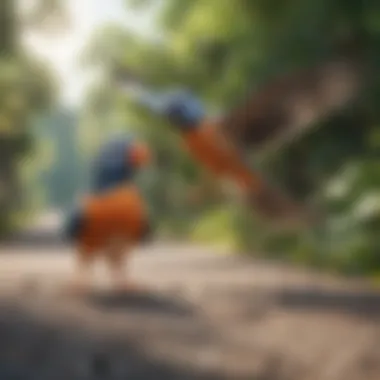
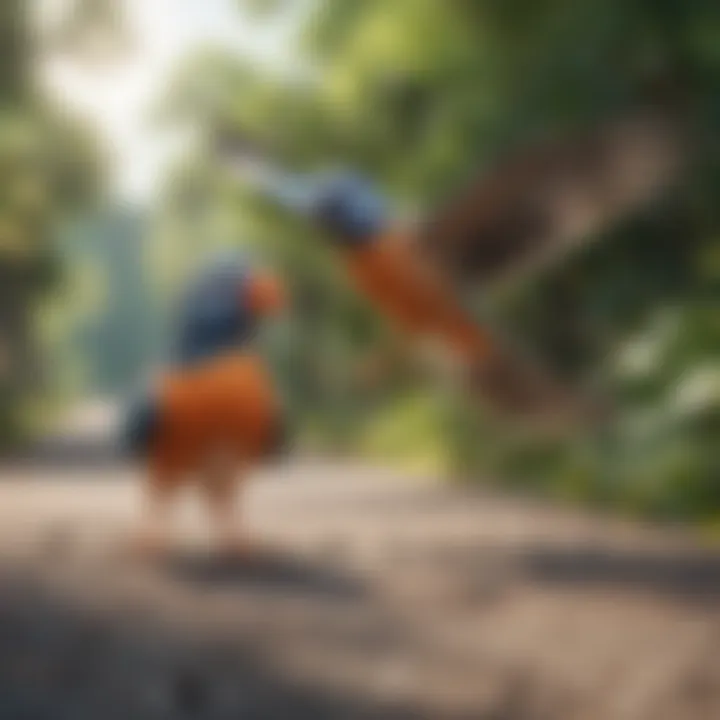
To develop your bird’s flight skills, start with small distances and gradually increase them as confidence builds. For instance, if you have a budgerigar, you might set up a training area between two perches, encouraging it to fly back and forth. Not only does this practice help improve its agility, but it’s also a good way to nurture trust, as the bird learns to rely on your commands.
Minimizing Hazards
Reducing hazards is a crucial part of ensuring a safe flight environment. Birds are curious creatures, and their explorative instincts can lead them into tricky situations. Common household items can pose dangers—open windows, ceiling fans, and even certain plants can become potential threats.
Here are some practical strategies for minimizing hazards:
- Window Screens: Ensure all windows are fitted with screens to prevent escapes and eliminate the risk of injury.
- Remove Toxic Plants: Familiarize yourself with common houseplants that are toxic to birds and ensure they are kept out of reach or removed entirely.
- Secure Loose Wires: Tuck away electrical cords and ensure they are not dangling within your bird's reach, preventing chewing or entanglement.
By taking these precautions, you create an environment where your bird can explore and fly without constant fear of encountering something dangerous.
Best Practices for Flight Safety
Implementing best practices for flight safety is essential for both the enjoyment of flying and minimizing accidents. These practices serve as guidelines that can help in establishing habits that keep your pet bird safe during its flying escapades.
- Supervised Flight Time: Always supervise your bird during flight sessions, particularly when you first introduce it to a flying environment.
- Use Flight Harnesses: Consider using a flight harness for outdoor flights. It's a good way to give the bird space while keeping it safe from external dangers.
- Regular Environment Checks: Frequently inspect the area for potential hazards and changes, like new furniture or designs, that might alter the space significantly.
"Creating a safe fly zone for birds not only helps them exercise but vastly improves their mood and overall health."
Keeping these best practices in mind can help mitigate risks and ensure a fulfilling experience for both birds and their owners.
Training Your Pet Bird to Fly
Training a pet bird to fly effectively is not simply a fun activity; it plays a pivotal role in ensuring the overall well-being of your feathered friend. By instilling confidence in your bird and fostering a meaningful connection between you and your companion, the training process can enhance your bird's flight skills significantly. Moreover, proper training can minimize flight-related fears, paving the way for a more harmonious home environment.
Building Trust and Communication
The first step in training a bird to fly lies in establishing a solid foundation of trust and communication. Birds are naturally sensitive creatures, often wary of sudden movements or unfamiliar sounds. To lay the groundwork for a trusting relationship, spend time calmly interacting with your bird, using soft tones and gentle movements.
- Step-Up Training: Start teaching your bird to step onto your finger or hand. This simple exercise reinforces the bond between you two and helps your bird feel more at ease.
- Body Language Matters: Learn to recognize your bird's body language. Signs of comfort include relaxed feathers or playful chirping, while fluffed feathers or silence can indicate stress.
Using consistent cues, whether verbal or physical, aids in establishing clear lines of communication. Birds can respond well to a mix of verbal praise and gentle petting, which adds another layer to your relationship.
Positive Reinforcement Techniques
Positive reinforcement is a powerful tool when it comes to training a pet bird. This method involves rewarding your bird for desirable behaviors, thus motivating them to repeat those actions. Rewards can be anything from treats to verbal praise or even toys that engage their interest.
- Timing is Key: Ensure that you immediately reward your bird after it performs the desired behavior. This helps create a clear association between the action and the reward.
- Choice of Treats: Determine which treats your bird finds most appealing. Certain fruits, seeds, or even special pellets can work wonders. It’s important similar to providing the right bait for fishing; the right treat can make all the difference.
- Gradual Steps: Start with small tasks. For instance, if you wish to train them to fly from one perch to another, reward successful landings each time.
By utilizing positive reinforcement consistently, you’ll not only cultivate a skill set in your bird but also strengthen the bond between you two over time.
Gradual Prolusion to Flight
When introducing your bird to flying, a gradual approach is essential. Jumping straight into long flights can overwhelm a bird, especially those that are new to the experience. Begin by allowing your bird to get comfortable with smaller distances.
- Short Distances: Start with short flights; allow your pet to fly between two close perches. This makes the flying experience feel less intimidating.
- Safe Landing Spots: Create safe landing areas to help your pet feel secure. Using soft surfaces and avoiding high areas can help prevent accidents and injuries.
- Increase Distance: Once your bird is confident with shorter flights, slowly increase the distance. Monitor their readiness, adjusting based on their comfort level.
Every bird has unique abilities and confidence levels, hence patience is fundamental through this process. Allow your bird to progress at its own pace; what works for one may not work for another.
"Taking the time to build trust, using rewards, and increasing flying distances gradually creates a nurturing environment for your pet, helping them to thrive in their natural instincts."
This gradual yet methodical approach allows your bird not only to develop strong flight skills but to do so in a way that’s enjoyable and stress-free for both you and your avian companion. It ultimately culminates in an enriching experience, where flight becomes a celebrated activity rather than a precarious hurdle.
Monitoring Health and Fitness
Monitoring health and fitness in pet birds is vital for their overall well-being. A well-kept feathered friend can lead to a vibrant and engaging life. It's not just about watching them fly around; it's about ensuring they are physically and mentally fit. When pet birds are healthy, they can express their natural behaviors, including flight.
Several elements come into play when considering the health and fitness of your avian companion. Observing their behavior and appearance is one crucial aspect. For example, a bird that is fluffed up, has ruffled feathers, or appears lethargic may be signaling discomfort or illness. Keeping tabs on any noticeable changes can help you catch potential health issues early on. A key benefit of monitoring is the ability to act swiftly whenever you notice something amiss. Also, investing the time to gain knowledge about bird diseases may save you both heartache and expense in the long run.
Recognizing Signs of Illness
Being attuned to your bird's habits allows you to recognize signs that may indicate illness. Birds often hide illness exceptionally well, a trait that can make detection challenging. Here are a few signs to watch for:
- Change in vocalization or reduced chatter
- Changes in droppings, such as color or consistency
- Excessive sleep or unusual lethargy
- Abnormal feather loss or loss of brightness in feathers
- Loss of appetite or changes in eating habits
If any of these symptoms arise, consulting a veterinarian experienced in avian care is crucial. Quick responses can help manage health issues more effectively.
Dietary Considerations for Active Birds
Nutrition holds significant importance in the lives of pet birds, especially active ones. A well-balanced diet supports their physical ability to fly, plays a hand in feather quality, and enhances overall vitality. A mix of seeds, pellets, fresh fruits, and vegetables creates a healthy foundation.
It's common to see many owners provide seeds as primary food. However, seeds alone often don't meet the nutritional needs of many birds. For instance, pelleted diets offer a more balanced alternative. Here are some dietary components to consider:
- Fruits: Offer cranberries, apples, or pears in moderation; they're fun and beneficial.
- Vegetables: Dark leafy greens are particularly crucial, providing essential vitamins.
- Seeds and pellets: Look for high-quality options that keep your bird active.
Routine Care and Wellness Checks
Regularly scheduled care and wellness checks play a pivotal role in maintaining a happy and healthy bird. A basic routine includes:
- Nail trimming: Typically every few weeks to ensure they don’t become overly long.
- Feather care: Regular baths, either via misting or shallow water, can help maintain feather health.
- Physical exams: Periodically visiting a vet allows you to catch any potential concerns before they escalate.
Using a checklist to remind yourself of these tasks can be helpful. Aspects like checking beak and tail for abnormalities, assessing body weight, and ensuring proper condition can all fall under this umbrella.
"An ounce of prevention is worth a pound of cure."
Common Challenges of Flight
When it comes to pet birds, flight isn't just an amusement; it's a vital aspect of their physical and mental health. However, navigating the skies isn't always smooth sailing for our feathered friends. Various challenges arise that can affect a bird’s ability to fly confidently. This section digs into these common hurdles to provide a comprehensive understanding of the factors influencing flight for pet birds.
Fear of Flying
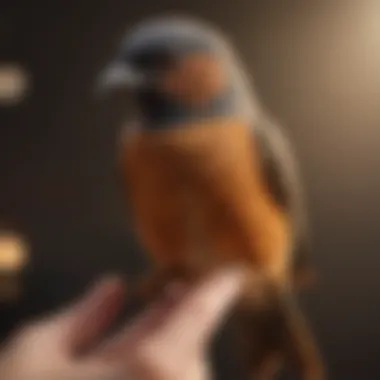
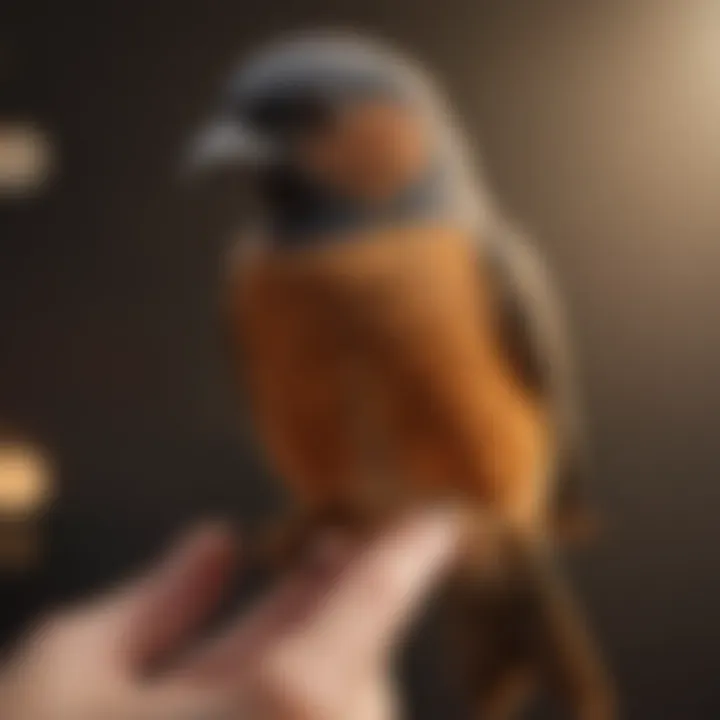
One of the most significant barriers pet birds face is the fear of flying. This can stem from a variety of experiences, including rough landings or stressful encounters with other animals. Birds, by nature, may feel vulnerable at high altitudes, which can trigger flight anxiety. For instance, a cockatiel might hesitate to soar if it once flew too close to a startled cat or if a loud noise caused it to flutter in panic.
Addressing this fear involves gradual exposure and patient training. A approach is the "step-up" method, where pet owners slowly encourage their birds to step onto their hands or perches. By associating time outside the cage with safety, birds can build up the confidence needed for flight.
Positive reinforcement is crucial. Rewarding progress—whether a simple flap of wings or a full flight—reinforces the behavior. As the saying goes, "Patience can conquer mountains!" This adage holds true when overcoming the fear of flying in pet birds.
Injuries from Flight
Injuries during flight are another pressing concern. While pet birds often display agility in their movements, accidents can happen in an instant. For instance, a bird may misjudge its landing and collide with furniture or a wall, leading to wing injuries or broken bones. Additionally, unmonitored flights might expose birds to potential hazards, such as sharp objects or other pets that could interact unfavorably.
To mitigate these risks, it’s essential to create a well-restricted environment where pets can exercise their flight abilities safely. Owners should ensure that all windows are secured with screens and that sharp edges are covered or removed. Training is key here too. Teaching birds to perform controlled flight patterns can significantly reduce the chances of injury. Regular health check-ups will also help spot any injuries early on before they turn serious.
"A safe bird is a happy bird."
Behavioral Issues Related to Flight
Lastly, behavioral issues related to flight cannot be overlooked. Birds are creatures of habit, and if they feel their flight is restricted, they might manifest unwanted behaviors, such as excessive screeching or feather plucking. A parakeet, for example, may become anxious and agitated if it doesn't engage in regular flight activities, leading to potential psychological problems.
Understanding the reasons behind these behaviors can be quite complex. Diminished flight opportunities can stem from a sense of confinement or boredom. Owners must actively work to incorporate flight into the bird’s daily routine. Activities like stimulating flying exercises or the introduction of aerodynamically interesting toys can be beneficial. Over time, as birds interact more with their environments through flight, their behaviors may normalize.
In summary, while obstacles such as fear of flying, injuries, and behavioral issues exist, addressing these challenges equips pet owners with the tools needed to nurture a comprehensive flight experience. Ensuring that the bird can take to the skies safely not only fosters a happier pet but also strengthens the bond between the owner and their avian companion.
Enhancing the Flight Experience
When it comes to pet birds, the ability to fly is not just a means of transportation; it’s an essential part of their well-being. Enhancing the flight experience can significantly impact how a bird interacts with its environment. It allows for physical exercise, mental stimulation, and a sense of freedom. The dynamics of a pet bird's flight are interwoven with its overall health and happiness. Creating a space where these creatures can soar, explore, and engage is crucial. Whether you’re a seasoned bird owner or just stepping into the avian realm, understanding and enhancing this aspect is paramount for fostering a satisfying relationship with your feathered companion.
Enriching Activities for Flight Time
To make flight time meaningful, consider introducing a variety of engaging activities. Think beyond simple flying; birds thrive when their environment sparks curiosity. You can use toys designed for flight, such as those that flutter or spin in the air. Set up obstacle courses for your bird to navigate using perches, hoops, and tunnels. Activities like these do not merely entertain — they mirror the challenges birds might face in the wild, promoting both fitness and mental agility.
Additionally, consider incorporating some interactive training sessions. Teach your bird tricks that encourage flying, like flying to your hand or moving from one perch to another. This not only enhances their flying skills but fosters a deeper bond between you and your pet.
- Rotating toys can keep things fresh, ensuring that your bird does not get bored.
- Consider creating a mimicry game, where your bird has to imitate sounds or actions as it flies.
Creating Flight Patterns and Routines
Establishing a routine for flight can bring structure to your bird's day while enhancing its overall physical health. Birds, much like any creature, thrive on predictability. Set specific times for flying, allowing your bird to anticipate these moments. This routine can help lower anxiety levels and build confidence.
When creating these flight patterns, consider the layout of your home. A safe path, free from obstructions like hanging lamps or open windows, helps create a space where the bird can truly stretch its wings.
- Use visual cues to indicate when it’s time to fly — a specific sound or an action that signals the start of flight time can be beneficial.
- You can also establish goal-oriented flight plans, encouraging your bird to fly longer distances or engage in multiple maneuvers as they become more confident.
Utilizing Natural Elements in Flight Spaces
Integrating natural elements into your bird's flight space can make a world of difference. Just as a bird would navigate trees and open skies in nature, mimicking these conditions can enrich their experience. Adding natural perches made of branches or using plants provides a more stimulating environment.
- Bird-safe plants, like spider plants or parlor palms, bring both aesthetics and natural elements to your space.
- If possible, designate a part of your home with plenty of sunlight and fresh air. This not only enhances their mood but provides essential energy for their flights.
Incorporating water features, such as birdbaths or water dishes that encourage splashing, can also delight your pet and make the flight experience different every time. These natural elements can awaken instincts that speak to the essence of being a bird.
"Creating a world where your pet can fly freely resembles the vast landscapes our feathered friends are born to explore; it impresses both the spirit and body of our cherished companions."
By implementing these suggestions into your home, you lay the groundwork for a rich, fulfilling flight experience that reflects the innate behaviors and needs of pet birds.
The Role of Flight in Socialization
Socialization is a vital part of a pet bird's life. For these feathered creatures, flight plays a key role in how they interact with the world around them. Let’s dive into the intricate connections between flight and social interactions, highlighting the remarkable effects it has on the social dynamics among pet birds and their human companions.
Interacting with Human Companions
For many bird owners, the bond they share with their avian friends is a source of joy and companionship. When a bird is able to fly, it creates an environment of freedom that boosts their confidence and enhances their social skills. Imagine a cockatiel fluttering through the room, perching on your shoulder while you work. This not only strengthens your interaction but also reinforces the bond you have.
- Confidence Building: Birds that can fly learn to trust their humans more. They can choose to come to you, inviting contact rather than merely being passive pets.
- Reading Body Language: Through flight, birds communicate their emotions more clearly. A happy bird may swoop around playfully, while a scared one may retreat. Understanding these cues strengthens your relationship.
- Active Play: Incorporating flight into games can enhance the human-bird connection. Games like chasing a feather or flying through hoops can be immensely enjoyable for both you and your bird.
Coexistence with Other Birds
Flight not only enriches the bond between humans and birds but also plays an essential role in how birds interact with fellow feathered friends. When birds can fly, they are more inclined to engage with each other, establishing their social hierarchy and wellness.
- Establishing Dominance: For species that engage in flocking behavior, flight allows them to display their status among peers. Through acrobatic feats or assertive flights, they showcase their strengths.
- Social Learning: Young birds can learn from observing others in flight. They mimic experienced birds, which is crucial for their social development. They pick up on nuances, learning everything from feeding habits to social hierarchies.
- Bonding Over Flight: Birds often engage in playful flight with one another, which cements their friendships. You might observe a budgie darting playfully in the air with another budgie as they practice their flying maneuvers together.
Flight and Bonding Opportunities
The act of flying can significantly enhance bonding opportunities for both birds and their human counterparts. It allows for shared experiences that enrich relationships.
- Shared Adventures: Organizing safe flight periods allows humans and birds to partake in adventures together. Whether it's flying in circles around you or exploring designated flight areas, this shared experience unites you both.
- Creating Flight Circuits: Designing a circuit for your pet to follow can be a form of interactive play. Bird owners can establish routes involving obstacles and landing spots to create a fun environment for their pets.
- Training Sessions: Incorporating flight into training can deepen the understanding between you and your bird. Training them to fly to you on command not only reinforces their exercise but strengthens your bond through trust.
"A bird in flight is a symbol of freedom, and that freedom fosters social connections that can lift our spirits as well as theirs."
Finale: The Importance of Flight for Pet Birds
Reflecting on the flight dynamics of pet birds, one can't understate the vital role that flight plays in their day-to-day lives. Flight isn’t just a whimsical activity; rather, it holds numerous benefits that contribute to the overall health, happiness, and well-being of these feathered companions. When pet birds fly, they engage their natural instincts and fulfill behaviors that are deeply ingrained within them. Healthy flight habits can lead to a flourishing bond between the bird and its owner while improving the pet's quality of life.
In this context, the significance of flight goes beyond mere exercise; it serves as a crucial component of their physical and psychological health. It helps regulate their weight, strengthens their muscles, and stimulates their minds. Furthermore, the freedom to flutter and soar nurtures their spirits, reflecting their wild ancestry and social structures.
"Flight is not just an option; it is a necessity that connects our birds to their roots and to us."
Recapitulation of Key Insights
As we examine the various aspects discussed in this article, a few key insights emerge:
- Natural Instincts: Birds are inherently designed to fly. Recognizing and understanding this instinct can help owners create a more meaningful and fulfilling environment.
- Health Benefits: Regular flight contributes to physical health by preventing obesity and promoting cardiovascular function. Moreover, mental stimulation from flying reduces boredom and associated behavioral problems.
- Safe Spaces: Creating safe environments encourages birds to explore their flight abilities, giving them the confidence to take off without undue stress. Owners must consider eliminating hazards and providing dedicated flight areas at home.
- Training and Socialization: Proper training techniques foster trust and communication, allowing birds to engage with their environment and their human companions while enhancing social bonds.
Final Thoughts on Avian Care
As we wrap up this exploration into the dynamics of pet birds in flight, it's clear that responsible avian care extends well beyond feeding and housing. Providing opportunities for flight is essential not just for physical health but also for emotional well-being. Owners should strive to weave flight time into the daily routine, thus allowing birds to express their natural behaviors. This ongoing commitment to flight will ultimately create a stronger bond, fostering happiness for both pet and owner.
Ensuring your bird has the chance to fly needs attentive consideration – it’s about creating an environment filled with trust, safety, and companionship. By understanding the power of flight in their life, owners can open doors to a happier and healthier pet bird, leading to a fulfilling avian companionship.















